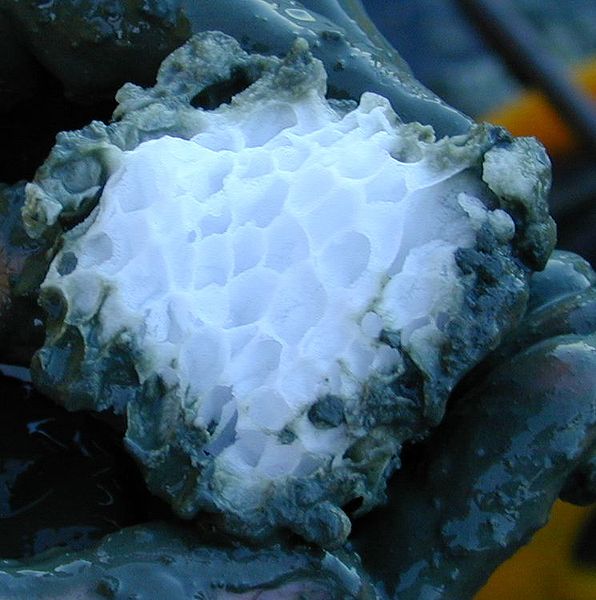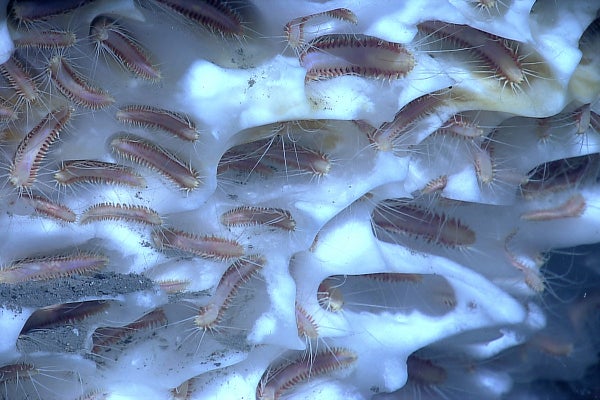Turning big, frozen deposits of methane buried under the seafloor into fuel for our cars and homes is coming closer to reality. As Japan, China and to a lesser extent the U.S. try to tap these abundant resources, important questions are arising about just how much they may contribute to climate change. The answers seem to range widely, depending on who is talking.
This issue has quickly risen because Japan conducted its second production test of these deposits, known as methane hydrates, in May. China soon followed with its first attempt to do the same. The news caught natural resource experts off guard because most of them thought it would still be years before nations tried to turn these icy gases into commercial products.
Production might still be a decade or more away in the U.S., which has been a quiet partner with Japan and China, although the Department of Energy has begun discussions with Alaska and Japanese interests about performing an extended production test in Alaska’s North Slope. The negotiations are considered “delicate,” says Tim Collett, a U.S. Geological Survey research geologist. Hydrates exist in the already commercialized Gulf of Mexico, too. If fully developed, hydrates around the globe could provide as much energy worldwide as natural gas does today.
On supporting science journalism
If you're enjoying this article, consider supporting our award-winning journalism by subscribing. By purchasing a subscription you are helping to ensure the future of impactful stories about the discoveries and ideas shaping our world today.
Hydrates form when gas and water molecules fuse in low-temperature, high-pressure conditions. A cagelike structure of solidified water traps methane within it. Most of the deposits, some small and some large, are buried in or below permafrost and sediments in the ocean bottom along continental margins—where shallow offshore waters slope down toward the deeper ocean floor. Nearly 99 percent of them outside Antarctica reside in sediments along continental slopes, more than 500 meters underwater in midlatitudes, 300 meters in higher latitudes. The remaining 1 percent occur in polar latitudes, mostly in permafrost soils onshore and beneath the Arctic Ocean.

Structure of a hydrate block embedded in the sediment of hydrate ridge. Credit: Wussel 007 Wikimedia(CC BY-SA 3.0)
As countries produce more conventional and unconventional fuels, the planet is warming in areas where methane hydrates exist. Those intertwined realities bring several hot-button issues to the fore:
Some of the methane hydrates in the Arctic and upper continental slopes such as the northern Pacific Ocean are beginning to thaw as temperatures rise. But it is an open question whether the methane molecules released can rise through the water column into the air. Even where methane increases are observed at the ocean surface, scientists need better data to determine whether emissions come from hydrates or other seafloor sources.
A 2009 study of the West Spitsbergen continental margin north of Norway in the Arctic Ocean, led by University of Birmingham geophysicist Graham Westbrook, put into perspective the challenges the scientific community faces. The study observed active methane plumes rising from the seabed, but most of the gas was not from hydrates and much of it did not reach the atmosphere. The situation, however, could change as ever-warming waters soften permafrost below, releasing methane, which in the atmosphere enhances warming further, creating a positive feedback loop.
Most methane hydrates are buried in ocean water so deep that the journey through the water column is too far for the gas to ever reach the atmosphere, according to Ed Dlugokencky, a researcher at the National Oceanic and Atmospheric Administration. In the shallower Arctic Ocean most of those deposits are tucked underneath a thick layer of sediment, impeding their travel. Dlugokencky, in an e-mail, wrote there have been “no significant increases in Arctic emissions over the past few decades” and that it would take “centuries” for warming to affect methane hydrate–bearing sediments. Even then, releases would be “slow and gradual.”
Other experts, though, say thinning ice sheets on land and calving ice shelves on the sea are reasons for alarm. Proponents of the so-called “methane time bomb” theory note the crumbling of glaciers in past eras destabilized methane hydrates, creating “blowouts.” As ice sheets dwindle, they lessen the pressure on gases bubbling below sediments enough that the gases can suddenly push sediment upward with a boom of force, resulting in heavy venting.
A June 2017 study by the Center for Arctic, Gas Hydrate, Environment and Climate (CAGE) concluded those unexpected methane blasts, rather than gradual releases, are a big problem. The study revealed that craters, formed from methane blowouts about 12,000 years ago as glaciers receded, are much larger than previously thought. Some of them are “actively seeping methane” from the Barents Sea floor near Norway. Marine geologist Karin Andreassen at CAGE, the study’s lead author, says the data could hold lessons for retreating ice sheets in West Antarctica and Greenland, although her team could not determine how much methane actually escaped into the atmosphere from blowouts in the distant past.
Patrick Crill, an American biogeochemist at Stockholm University, says ice core data from the past 800,000 years, covering about eight glacial and interglacial cycles, show atmospheric methane concentrations between 350 and 800 parts per billion in glacial and interglacial periods, respectively. Spikes never exceeded 800 ppb and it is unlikely hydrates accounted entirely for those occurrences. Today there is roughly 1,900 ppb of methane in the atmosphere already. Much of that could be from organic matter decomposing in permafrost as global temperatures rise, and not specifically from hydrates.
The methane hydrates with the highest climate susceptibility are in upper continental margin slopes, like those that ring the Arctic Ocean, representing about 3.5 percent of the global methane hydrate inventory, says Carolyn Ruppel, a scientist who leads the Gas Hydrates Project at the USGS. Even if warming releases those hydrates, it would occur on a timescale of centuries and it is unclear how much would escape into the atmosphere, she says. That is because some organisms can consume the methane as it travels up the water column and because some of the gas naturally dissolves to raise surrounding low-methane seawater to higher, standard levels.
Beyond that, more than 95 percent of the world’s methane hydrates exist in deep-ocean settings where it is unlikely water would ever heat up enough to significantly destabilize them. And hydrates in subsea or onshore permafrost are mostly buried under 200 meters of sediment, also unlikely to escape. Ruppel says “there’s been a lot of acrimony” over how much methane from hydrates would interact with the air. The problem, she says, “is sometimes the loudest voice gets the most attention.”
That loudest voice is coming from a group of scientists studying the eastern Siberian Arctic shelf. They say the shelf heralds a possible catastrophe, because the frozen salty marsh there is loaded with methane. Research in 2008 led by oceanographer Natalia Shakhova, now at the University of Alaska Fairbanks, estimated the thawing shelf could release a 50-gigaton pulse of methane from hydrates over 10 years—about 8 percent of the methane stored in the shelf’s sediments. A follow-on 2013 study from another team valued the economic cost of that release at $60 trillion, which would be incurred mostly by developing countries in the form of increased droughts, floods and famine.
Shakhova’s team said one gigaton of methane now escapes annually from the sediments, largely through a growing network of crevices known as taliks in the Arctic permafrost. That figure will rapidly increase each year as warmer temperatures thin permafrost, Peter Wadhams, a professor of ocean physics at the University of Cambridge and co-author of the economic impact study, wrote in an e-mail.
Research indicates methane concentrations in the air above the Arctic Ocean are rising. A 2012 Nature study led by University of Michigan climate researcher Eric Kort indicated methane fluxes there are similar to those on the Siberian shelf. But that study said it is uncertain how much hydrates contribute to the methane emissions, as opposed to other sources such as the decomposition of organic matter in permafrost as it thaws.
Crill, and Stockholm University colleague, atmospheric chemist Brett Thornton, ventured to the East Siberian Arctic shelf to observe the area’s infamous venting. They found methane fluxes, but not as high as the Shakhova study, and they could not attribute what they found directly to methane hydrates. Most of the shelf is too shallow for methane hydrates, Thornton says. The shelf’s more likely culprit for emissions is methane escaping through cracks and subsea permafrost thaw, he says. That distinction would mean methane hydrates are more stable than some fear. “No one has yet shown that CH4 [methane] from hydrates is reaching the atmosphere today,” Thornton says. “We (and others) have seen CH4 reaching the atmosphere from seafloor sources, notably on the East Siberian Arctic shelf, and smaller amounts elsewhere. Are these hydrate-derived? Maybe, maybe not.”
Drilling into hydrates to mine energy could change the equation. Drilling and piping methane to the ocean surface could release the gas into the atmosphere. So could transporting it through pipelines. These kinds of leaks from production and transportation of natural gas resources have been well documented. Countries exploring methane hydrate production are still trying to properly design wells. Methane hydrates, after all, were largely responsible for corrupting the containment dome intended to stop the 2010 Deepwater Horizon oil spill rising from the ocean bottom; the viscous mixture clogged the dome and a redirection pipe intended to take leaking oil to a tanker waiting above. Tapping into thawing permafrost for methane—which does not necessarily mean methane hydrates—would also present similar risks in producing conventional natural gas.
The related question is whether consuming methane hydrates for fuel is environmentally responsible. Methane is a potent greenhouse gas with more climate warming effect than carbon dioxide, the main driver of global warming. Burning more methane continues the trouble of burning fossil fuels. Countries like Japan view methane hydrates as a way to reduce their dependency on imported fuel. India, another country conducting field tests, wants to supply the energy-hungry subcontinent. It may not be long until the U.S., which has partnered in virtually every existing program around the world, dips into its own resources in Alaska’s North Slope.
Collett cautions that right now “we’re still dealing with largely a research issue.” Commercialization is not guaranteed. Some hydrates would not be developed out of technical constraints, others because the economics would be too costly to pull them from the seafloor. The limited tests in Japan and China are only meant to gauge how a reservoir would react to the piercing of a drill bore and how a well would respond to the depressurizing hydrate as it is extracted. The potential North Slope tests would reveal how a reservoir’s physical properties might shift as well as how fast and with what pressure gas escapes—all crucial data for designing good production wells.
If production ultimately began, that would add another fossil fuel to the world’s energy mix when humanity is already baking the planet beyond its capacity to cope. More than ever, Collett faces questions from Indian researchers and the media about the strain methane hydrate development may place on India’s environment. The conversation extends well beyond the technical producibility of the resource. “Gas hydrates have all the same impacts as other fossil fuels,” he says. “It becomes a societal discussion.”
